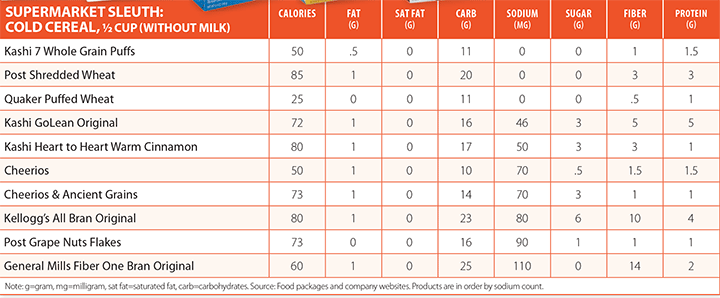Start Your Day with a Healthy Ready-to-Eat Cereal
Nearly 287 million people in the U.S. have eaten ready-to-eat cereals this year, according to consumer research company Simmons and U.S. Census data. But, with all the sugary varieties available today, it can be a challenge to find a cold cereal that is both healthy and flavorful. Here are some helpful tips for making the right cereal choices.
Healthy Ingredients
“Whole grains should be the primary ingredient in cereals,” says Jenna Rosenfeld, registered dietitian at Weill Cornell Medicine. Whole-grain cereals are rich in fiber and several nutrients and can help lower your cholesterol and reduce your risk of heart disease. Fiber also helps reduce risk of type 2 diabetes, obesity, and cancer.
DON’T FORGET PORTION SIZE
Cereal label portions range from ½ cup to 1½ cups. And, some people pour 2-3 servings and continue eating until they are stuffed. Limit your cereal intake to one portion and use skim or 2-percent milk.
Other common ingredients in healthy cereals include nuts, seeds, and spices. Healthy cereals also have vitamins and minerals, such as A, B, C, D, E, calcium, iron, and zinc (some have been added during processing). Whole-grain cereals are good sources of fiber, and many are gluten free.
Not-So-Healthy Ingredients
“The number one problem with cereals is sugar content,” Rosenfeld says. Most manufacturers add it to improve flavor.
Your sugar goal should be as close to zero as possible. “A rule of thumb is that the fiber in your cereal should be close to the same amount, if not higher, than the sugar amount,” says Rosenfeld.
In addition to the Nutrition Facts label, be sure to check the ingredients list. Sugar comes in many forms, including brown sugar, corn syrup, cane syrup, honey, malt syrup, fructose, and sucralose. Also, be wary of added fruit, because it often is coated in sugar, especially dried fruit, which is even higher in calories and sugar, and should be limited.
Sodium should be kept under 150 milligrams. Additionally, avoid refined grains and choose cereals that start with the word “whole” on the ingredient list.
There are many ingredients in cold cereals that are not healthy and that you should be wary of. When it comes to the ingredients list, follow this rule of thumb: The fewer items, the better.

The post Start Your Day with a Healthy Ready-to-Eat Cereal appeared first on University Health News.
Read Original Article: Start Your Day with a Healthy Ready-to-Eat Cereal »
Powered by WPeMatico

